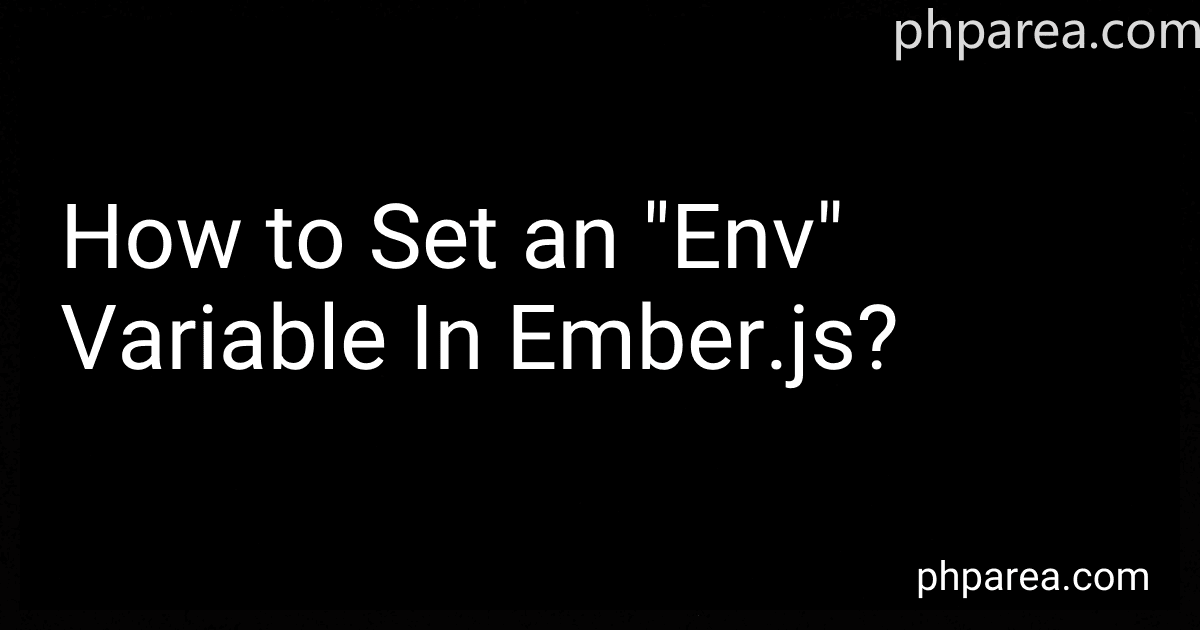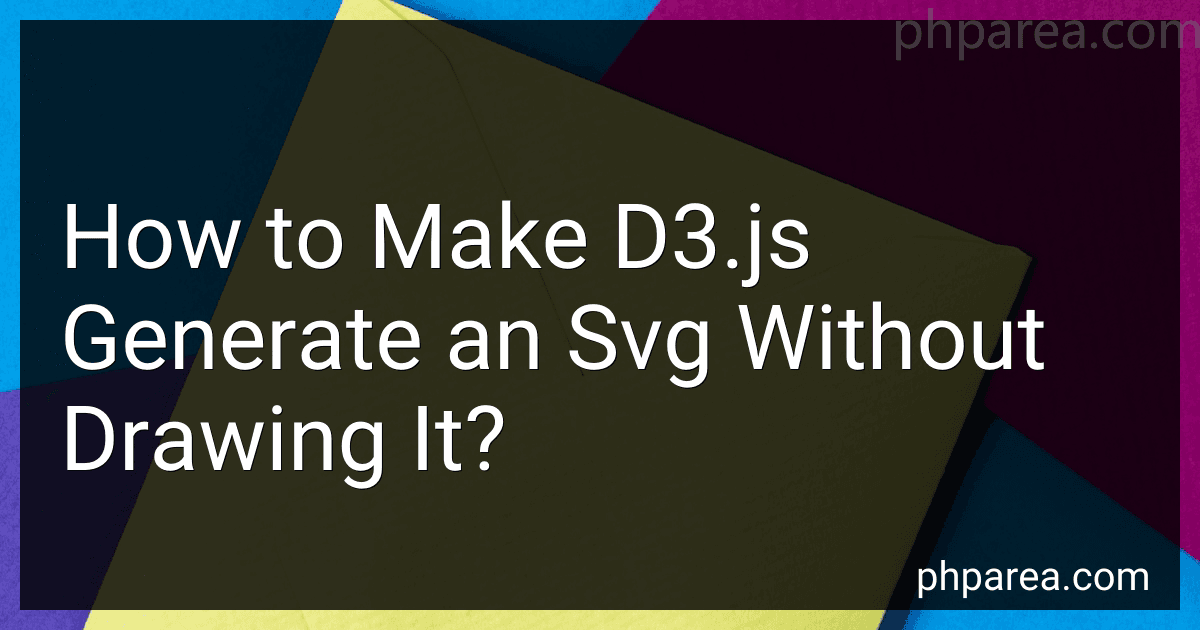Posts (page 88)
-
 5 min readTo set an "env" variable in Ember.js, follow these steps:Open your Ember.js project in a code editor. Locate the .env file in the root directory of your Ember.js project. If the file does not exist, create a new file and name it .env. Inside the .env file, add the variable you want to set in the following format: VARIABLE_NAME=variable_value Replace VARIABLE_NAME with the desired name for your environment variable and variable_value with the actual value you want to assign to it.
5 min readTo set an "env" variable in Ember.js, follow these steps:Open your Ember.js project in a code editor. Locate the .env file in the root directory of your Ember.js project. If the file does not exist, create a new file and name it .env. Inside the .env file, add the variable you want to set in the following format: VARIABLE_NAME=variable_value Replace VARIABLE_NAME with the desired name for your environment variable and variable_value with the actual value you want to assign to it.
-
 7 min readScaling in d3.js refers to adjusting the size or range of data in a visual representation to fit within specified boundaries on a canvas. It ensures that the data can be properly displayed in the visualization. Scaling is an essential aspect of d3.js as it allows for precise mapping of data onto visual attributes such as position, size, and color.d3.js provides various scaling functions that transform data from the input domain to the output range.
7 min readScaling in d3.js refers to adjusting the size or range of data in a visual representation to fit within specified boundaries on a canvas. It ensures that the data can be properly displayed in the visualization. Scaling is an essential aspect of d3.js as it allows for precise mapping of data onto visual attributes such as position, size, and color.d3.js provides various scaling functions that transform data from the input domain to the output range.
-
 8 min readIn Ember.js, binding events to dynamically created instances involves using the on method provided by the Ember framework. This method allows you to specify the event type and action to be triggered when the event occurs.To bind an event to a dynamically created instance, you can follow these steps:First, create a new instance of your object or component dynamically using the Ember factory methods, such as create() or extend().
8 min readIn Ember.js, binding events to dynamically created instances involves using the on method provided by the Ember framework. This method allows you to specify the event type and action to be triggered when the event occurs.To bind an event to a dynamically created instance, you can follow these steps:First, create a new instance of your object or component dynamically using the Ember factory methods, such as create() or extend().
-
 6 min readTo achieve an SVG output without immediately rendering it, you can follow these steps using d3.js:Import the necessary d3.js library in your HTML file. <script src="https://d3js.org/d3.v7.min.js"></script> Create an SVG container element. <svg id="svg-container"></svg> Define the width and height of your desired SVG. const width = 500; const height = 300; Create an SVG generator function using d3.js. const svgGenerator = d3.create("svg") .
6 min readTo achieve an SVG output without immediately rendering it, you can follow these steps using d3.js:Import the necessary d3.js library in your HTML file. <script src="https://d3js.org/d3.v7.min.js"></script> Create an SVG container element. <svg id="svg-container"></svg> Define the width and height of your desired SVG. const width = 500; const height = 300; Create an SVG generator function using d3.js. const svgGenerator = d3.create("svg") .
-
 6 min readIn Ember.js, you can add routes or states to the router dynamically at runtime using the Router.map method. This method allows you to define new routes or states within your application's router after the initial configuration.To add a new route or state dynamically, you can access the router within a component or controller and call the map method to define the route or state.
6 min readIn Ember.js, you can add routes or states to the router dynamically at runtime using the Router.map method. This method allows you to define new routes or states within your application's router after the initial configuration.To add a new route or state dynamically, you can access the router within a component or controller and call the map method to define the route or state.
-
 7 min readTo add an image to a rectangle in d3.js, you can follow these steps:Create a rectangle element using the rect() function in d3.js. Set the attributes such as coordinates (x, y), width, and height according to your requirements. For example: var svg = d3.select("svg"); var rect = svg.append("rect") .attr("x", 50) .attr("y", 50) .attr("width", 200) .attr("height", 100); Load the image using the image() function in d3.js.
7 min readTo add an image to a rectangle in d3.js, you can follow these steps:Create a rectangle element using the rect() function in d3.js. Set the attributes such as coordinates (x, y), width, and height according to your requirements. For example: var svg = d3.select("svg"); var rect = svg.append("rect") .attr("x", 50) .attr("y", 50) .attr("width", 200) .attr("height", 100); Load the image using the image() function in d3.js.
-
 7 min readIn Ember.js, the bind-attr syntax is used to dynamically bind HTML attributes to properties in a component or template. It allows you to update the attribute value automatically when the bound property changes.To use bind-attr, you specify the attribute you want to bind, followed by = sign and the property name inside double curly braces. For example, {{bind-attr class=myClass}} will bind the class attribute to the value of myClass property.
7 min readIn Ember.js, the bind-attr syntax is used to dynamically bind HTML attributes to properties in a component or template. It allows you to update the attribute value automatically when the bound property changes.To use bind-attr, you specify the attribute you want to bind, followed by = sign and the property name inside double curly braces. For example, {{bind-attr class=myClass}} will bind the class attribute to the value of myClass property.
-
 10 min readTo redraw data after zooming with d3.js, you can follow these steps:Store the initial state of the data before applying any zooming transformations.Add a zoom behavior to your d3.js visualization using d3.zoom().Define the zoom function that will be called when a zoom event occurs. Inside this function, you can modify the visual attributes of your data or redraw the entire visualization.Set the zoom behavior to listen for zoom events and call the zoom function when triggered.
10 min readTo redraw data after zooming with d3.js, you can follow these steps:Store the initial state of the data before applying any zooming transformations.Add a zoom behavior to your d3.js visualization using d3.zoom().Define the zoom function that will be called when a zoom event occurs. Inside this function, you can modify the visual attributes of your data or redraw the entire visualization.Set the zoom behavior to listen for zoom events and call the zoom function when triggered.
-
 4 min readIn Ember.js, controller initialization refers to the process of setting up a controller with the necessary data and properties. There are several ways to initialize a controller in Ember.js, depending on your specific requirements and preferences.One common approach is to use the init() method provided by Ember.js. This method is called when the controller is first created, allowing you to perform any necessary initialization tasks.
4 min readIn Ember.js, controller initialization refers to the process of setting up a controller with the necessary data and properties. There are several ways to initialize a controller in Ember.js, depending on your specific requirements and preferences.One common approach is to use the init() method provided by Ember.js. This method is called when the controller is first created, allowing you to perform any necessary initialization tasks.
-
 6 min readTo set an image as the background of a path in d3.js, you can follow these steps:First, make sure you have the image file you want to use. It could be in any supported format such as .jpg, .png, or .svg. In your JavaScript code, create a new SVG element using the .append() method on the main SVG container. Set the width and height of the SVG element according to your requirements. const svg = d3.select("body") .append("svg") .attr("width", 500) .
6 min readTo set an image as the background of a path in d3.js, you can follow these steps:First, make sure you have the image file you want to use. It could be in any supported format such as .jpg, .png, or .svg. In your JavaScript code, create a new SVG element using the .append() method on the main SVG container. Set the width and height of the SVG element according to your requirements. const svg = d3.select("body") .append("svg") .attr("width", 500) .
-
 8 min readTo test Ember.js routes, you can follow these steps:Start by creating a test file for your route. This can be done by using the ember-cli command-line tool, or by manually creating a new JavaScript file in the tests directory of your Ember.js project. Inside the test file, import the necessary modules for testing. Typically, you would import module, test, and any other dependencies needed for your testing setup. Create a test module using the module function.
8 min readTo test Ember.js routes, you can follow these steps:Start by creating a test file for your route. This can be done by using the ember-cli command-line tool, or by manually creating a new JavaScript file in the tests directory of your Ember.js project. Inside the test file, import the necessary modules for testing. Typically, you would import module, test, and any other dependencies needed for your testing setup. Create a test module using the module function.
-
 7 min readTo update a D3.js bar chart with new data, you can follow these steps:Select the chart container element: Start by selecting the container element in which the chart is rendered using D3.js. You can select it using CSS selector or by directly referencing the element using its ID or class. Define the updated data: Prepare the new data that you want to use to update the chart. This data should be in a format compatible with your chart implementation.
7 min readTo update a D3.js bar chart with new data, you can follow these steps:Select the chart container element: Start by selecting the container element in which the chart is rendered using D3.js. You can select it using CSS selector or by directly referencing the element using its ID or class. Define the updated data: Prepare the new data that you want to use to update the chart. This data should be in a format compatible with your chart implementation.